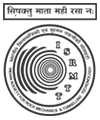Archives
Categories
Instructions
GENERAL
The forwarding letter for sending the manuscript of paper / technical note should contain the email addresses of all the authors and the mobile number of the corresponding author for speedy communication. A technical note is a short paper of restricted scope. The original copy of the completed manuscript / technical note in Word files either as an attachment or a downloadable link should be sent by email to the Editor.
The authors are expected to submit a declaration that the paper or a technical note being submitted for publication in JRMTT is their own work and has not been published anywhere in the past. The manuscript / technical note should be typed on A-4 size sheet, with right, left, bottom and top margins of 2cm.
The manuscript / technical note should be written in single space with a letter size of 12 pt in Times New Roman. The first page should contain the title of the manuscript/technical note, the author’s names and affiliations, the authors’ complete business address with email, Abstract and Keywords.
Page numbers should begin with the title page in Arabic numerals, and all pages should be numbered subsequently.
Manuscript / Technical note must meet the requirements outlined below [The template for preparing and formatting the manuscript is available at www.isrmtt.com]:
TITLE PAGE
This should have only the title of the article / technical note, author’s name, institution of origin with its address (including email address), abstract, keywords, text and necessary footnotes, if any.
ABSTRACT
An abstract of not more than 250 words is required for Research Articles. Abstract is not required for Technical Notes. Reference should not be cited in the abstract.
KEYWORDS
Keywords may be given as per requirement and should not exceed six (6 nos.). Keywords should be placed directly below the abstract.
Example: Anisotropic; Foliation joints; Deformation modulus; Uniaxial jacking tests.
TABLES
Tables should be numbered with Arabic numerals, have a brief caption, and be referred in the text. Column headings and descriptive matter in tables should be brief. Vertical lines should not be used. Numerous small tables should be avoided, and the number of tables should be kept to a minimum.
EQUATIONS AND FORMULAE
Equations and formulae must be set up clearly and should be typed using Cambria Math in 12 pt. Numbers identifying equations should be in brackets and placed flush with the left margin of the text.

PHOTOGRAPHS, FIGURES AND LINE DIAGRAMS
All illustrations, whether diagrams or photographs should be of high quality (TIFF, JPEG) and provided within the text, referred to as ‘Figures’ with their captions and numbered in Arabic numerals consecutively as they appear in the text.
Map, line figures or sketches should be provided within the text. Each diagram, map or sketch should carry a suitable title. Letters and numerals in the map, line diagram or sketches should be typed neatly and shall be legible.
REFERENCE
References should be cited in the text by author and year. In case of more than two authors, citation within the text should be to the first author followed by “et al.” and year (For example, Mitra and Singh, 1997; Hoek et al., 2013). References must be typed single-spaced and listed alphabetically. The full reference must be given in a list at the end of the paper in the following form.
Journal Articles
Mitra S and Singh Bhawani (1997). Influence of geological features on long term behaviour of underground powerhouse cavities in lower Himalayan region: a case study. Journal of Rock Mechanics and Tunnelling Technology, 3(1):23-76.
Neuzil CE and Pollock DW (1983). Erosional unloading and fluid pressure in hydraulically tight rocks. Journal of Geology, 91:179-193.
Article by DOI*
Dwivedi RD, Goel RK, Prasad VVR, and Sinha A (2008). Thermo-mechanical properties of Indian and other granites. Int J Rock Mech Min Sci, https://doi.org/10.1016/j.ijrmms.2007.05.008
(*DOI format shall be used if only Vol. and Page numbers of the article are unavailable)
Book
Goel RK, Singh Bhawani, and Zhao Jian (2012). Underground Infrastructures: Planning, Design and Construction, Elsevier Inc., USA, p.334.
Book Chapter
Harrison JP, Hudson JA, and Popescu ME (2002). Engineering rock mechanics: Part 2. Illustrative worked examples, p. B30-B31.
Goel RK and Singh B (2017). Tunnels in the Himalaya. In: Rock Mechanics and Engineering. CRC Press, Vol. 5, p. 69-108.
Conference Proceeding
Hoek E, Carter TG, Diederichs MS (2013). Quantification of the geological strength index chart. In ARMA US Rock Mechanics/Geomechanics Symposium 2013, pp. ARMA-2013.
Bhasin Rajinder and Thomas P (2013). Dynamic analysis of rock support in tunnels with a case study of a large underground cavern in the Himalayas: Keynote Lecture, Proc. 4th Indian Rock Conference Indorock’2013, May, Solan, India, pp.77-89.
Ph.D. Thesis / Dissertation
Mitra S (1991). Study on Long-term Behaviour of Underground Powerhouse Cavities in Soft Rocks. Ph.D. Thesis, Department of Civil Engineering, University of Roorkee (now IIT Roorkee), India, p. 193.
Online Document
Lanzano G, Bilotta E and Russo G (2008). Tunnels under seismic loading: a review of damage case histories and protection method (www.reluis.it/doc/pdf/Pubblicazioni/Lanzano-Bilotta-Russo.pdf), Downloaded in April 2013.
Reports
CSMRS (2016). Report on deformability characteristics of rock mass by uniaxial jacking tests in right bank drift D-2 at dam site of Pancheshwar Multipurpose Project, India / Nepal, CSMRS, New Delhi, p. 27.
EMAIL TO SUBMIT MANUSCRIPT / TECHNICAL NOTE
- Dr. R.K. Goel, Editor, rkgoel15@gmail.com
- Dr. R.D. Dwivedi, Associate Editor, rddwivedi@hotmail.com
